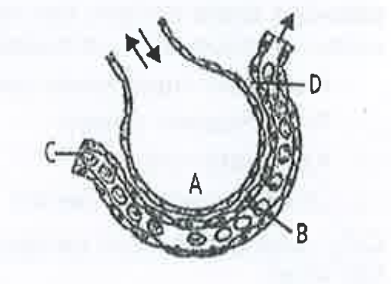The exchange of gases in old stems takes place from
Stomata
hydatodes
Lenticels
Passage cells
The correct Answer is:C
Step-by-Step Solution:
1. Understanding the Question: The question asks about the mechanism of gas exchange in old stems of plants.
2. Evaluating the Options:
- Option 1: Stomata: Stomata are small openings primarily found on the leaves of plants. They facilitate gas exchange (like oxygen and carbon dioxide) but are not involved in gas exchange in old stems. Therefore, this option is incorrect.
- Option 2: Hydathodes: Hydathodes are specialized structures found on leaves that help in the process of guttation, which is the exudation of water droplets from the leaf margins. They are not involved in gas exchange in stems. Thus, this option is also incorrect.
- Option 3: Lenticels: Lenticels are small openings found in the bark of woody plants, especially in older stems. They consist of loosely arranged cells that allow for gas exchange between the internal tissues and the atmosphere. Since old stems have an impermeable bark, lenticels are crucial for allowing gases to enter and exit. This option is correct.
- Option 4: Passage Cells: Passage cells are specialized endodermal cells found in roots, not stems. They do not play a role in gas exchange in old stems. Therefore, this option is incorrect.
3. Conclusion: After evaluating all the options, the correct answer is that the exchange of gases in old stems takes place from lenticels.
---
- Option 1: Stomata: Stomata are small openings primarily found on the leaves of plants. They facilitate gas exchange (like oxygen and carbon dioxide) but are not involved in gas exchange in old stems. Therefore, this option is incorrect.
- Option 2: Hydathodes: Hydathodes are specialized structures found on leaves that help in the process of guttation, which is the exudation of water droplets from the leaf margins. They are not involved in gas exchange in stems. Thus, this option is also incorrect.
- Option 3: Lenticels: Lenticels are small openings found in the bark of woody plants, especially in older stems. They consist of loosely arranged cells that allow for gas exchange between the internal tissues and the atmosphere. Since old stems have an impermeable bark, lenticels are crucial for allowing gases to enter and exit. This option is correct.
- Option 4: Passage Cells: Passage cells are specialized endodermal cells found in roots, not stems. They do not play a role in gas exchange in old stems. Therefore, this option is incorrect.
Topper's Solved these Questions
- ANATOMY OF FLOWERING PLANTS BOOK - CENGAGE BIOLOGY ENGLISHCHAPTER - ANATOMY OF FLOWERING PLANTS EXERCISE - ASSERTION-REASONING QUESTIONS
14 Videos
- ANATOMY OF FLOWERING PLANTS BOOK - CENGAGE BIOLOGY ENGLISHCHAPTER - ANATOMY OF FLOWERING PLANTS EXERCISE - ARCHIVES
38 Videos
- ANIMAL KINGDOMBOOK - CENGAGE BIOLOGY ENGLISHCHAPTER - ANIMAL KINGDOMEXERCISE - Archives
34 Videos
Similar Questions
Knowledge Check
The exchange of gases in the alveoli of the lungs takes place by
Apassive transportBactive transportCosmosisDsimple diffusion.
Give the biological terms for each of the following:
Blind sacs in the lungs where exchange of respiratory gases takes place.
View SolutionWhere does exchange of gases takes place?
View SolutionName the layers through which the exchange of gases takes place in the lungs.
View SolutionThe figure given below shows a small part of human lung where exchange of gases takes place. In which one of the option given below, the one part A, B, C or D is correctly identified along with its functions

View SolutionThe figure given below shows a small part of human lung where exchange of gases takes place in which one of the options given below the one part A,B,C or D is correctly identified along with its function

View SolutionDuring the exchange of gases in the human respiratory system ,Carbon dioxide is transported from tissues to respiratory surface by only
View SolutionThe exchange of gases between blood capillaries and alveoli in the lung is through
View Solution
